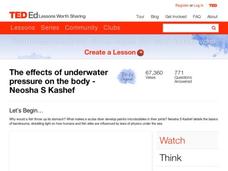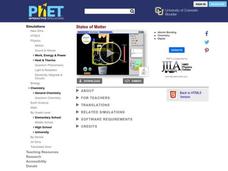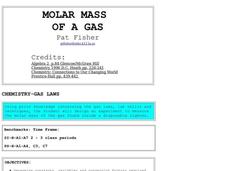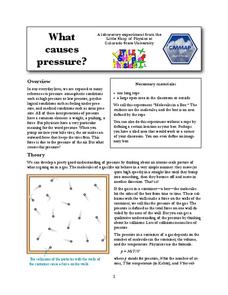Gas Laws Teacher Resources
Find Gas Laws lesson plans and worksheets
Showing 419 resources
Curated OER
It's Rainin', It's Pouring
Students take a quick examine part of the water cycle, and the combined gas laws. The lesson lead them through the conditions necessary for cloud formation and allow them to create clouds in three different hands-on activities.
Curated OER
Gas Laws
In this gas worksheet, students calculate molar mass and molecular weight of a given mass of gas at a specific temperature and pressure. Students calculate partial pressure of given gases. This worksheet has 6 word problems.
PHET
Gas Properties
We can't see most gases and we can't see things at the molecular level — but that's about to change! A simulation shows pupils the activity of molecules in a gas. The simulation allows scholars to vary the volume, heat, and...
Steinhardt Apps
Kinetic Molecular Theory
Building off young chemists' knowledge of the states of matter, kinetic molecular theory is the focus of the unit. Eight days of lessons including multiple demonstrations, one lab experiment, directed instruction, and worksheets,...
TED-Ed
The Effects of Underwater Pressure on the Body
Exactly what causes the the pain you feel when diving to the deep end of a pool? Find out with this short video that explores the physical laws governing the behavior of gases and the ways they affect marine life...
Concord Consortium
Gas Pressure in a Syringe
Plunge into a gas pressure activity! Junior physical scientists manipulate a syringe to study the particle model of gases. The interactive invites investigations of particle movements in capped versus uncapped syringes.
Teacher's Pet
Properties of Gases
What makes gases so unique? Physical science sleuths uncover the facts about gases in a short video. The narrator compares gases to solids and liquids in terms of space between particles, compressibility, and reaction to temperature...
Colorado State University
Why Does the Wind Blow?
Without wind, the weather man wouldn't have much to talk about! Blow away your junior meteorologists with a creative demonstration of how wind works. The activity uses an empty soda bottle and compressible Styrofoam peanuts to illustrate...
Kenan Fellows
Reading Airline Maintenance Graphs
Airline mechanics must be precise, or the consequences could be deadly. Their target ranges alter with changes in temperature and pressure. When preparing an airplane for flight, you must read a maintenance graph. The second lesson of...
Curated OER
Why Do Hot Air Balloons Float?
In this Charles' Law worksheet, students solve 8 gas law problems where the pressure is constant and the volume varies directly with the temperature.
Curated OER
Gas Laws
Eighth graders use lab work and software to collect and analyze pressure and temperature data in order to illustrate the relationship between the temperature and pressure of a gas at a constant volume. They conduct a lab and organize...
Curated OER
Individual Gas Laws
Students learn the relationships between the different properties of a gas and use previous knowledge and make predictions. They predit and explain certain phenomena of gases using their chemical knowledge.
PhET
States of Matter
Water is the only molecule on Earth that can naturally exist in all three states of matter. The interactive simulation shows different molecules changing states of matter with the addition or removal of heat. Learners then see how...
Curated OER
Molar Mass
Students apply the ideal gas law and Dalton's Law of Partial Pressure to develop an experiment which determine the molar mass of butane from disposable lighters. In small groups, they develop a procedure and have it approved before...
Curated OER
Behavior and Properties of Gases
Students convert Celsius to Kelvin temperature. Students conduct three lab experiments, gas law simulations using Internet applets, lectures and demonstrations. The Laws included are Boyle's, Charles, Combined Gas, Ideal Gas, and Gram's...
Curated OER
Chemistry First Marking Period Review
In this chemistry review worksheet, students review terms and concepts covered. Students practice metric conversions, factor labeling, temperature conversions, heat calculations, atomic structure, and gas laws. This worksheet has 3...
Crash Course
Partial Pressures & Vapor Pressure: Crash Course
How much pressure is exerted by the mixture of gases in a scuba tank? Introduce pupils to Dalton's Law of Partial Pressure and vapor pressure in the video sure to interest the class. The video also reminds viewers that gases are not...
Teacher's Pet
Gas Mixtures and Movements
Why do balloons go flat over time? The answer lies in the behavior of gases! Introduce young scientists to diffusion and effusion with a video. Pupils learn the composition and partial pressures of atmospheric gases as well as how the...
Colorado State University
What Causes Pressure?
Are you feeling the pressure? Let loose a little with a kinesthetic activity that models molecular motion in a closed space! The activity varies conditions such as volume and temperature and examines the effects on molecules.
Teacher's Pet
Temperature
What is temperature, and why are there three different temperature scales? Young scientists learn the true nature of temperature with an informative video. The narrator discusses all three temperature scales and the relationship between...
MinutePhysics
What is a Dimension? In 3D...and 2D...and 1D
How many dimensions are there? Latitude, longitude, and altitude are accepted dimensions, but what about time or another type of dimension? An engaging video describes how we theorize that we live in three dimensions and which laws of...
Krista King Math
Inverse Variation
Apply rational functions to a problem-solving situation through inverse variation. The video tutorial explains the concept of inverse variation and introduces learners to the formula. The instructor explains how to solve problems that...
Curated OER
Now Take a Deep Breath
Young scholars research to answer questions related to deep sea diving. In this deep sea diving lesson, students answer questions on a worksheet using the Internet. They discuss pressure, gas laws, and the physiology of diving in the...
Curated OER
Graham's Law
In this gas law instructional activity, students learn how Graham's law governs the diffusion of gases. Students calculate the velocity and effusion rate of gases at certain temperatures. This instructional activity has 6 problems to solve.
Other popular searches
- Gas Laws Lab
- Combined Gas Laws
- Ideal Gas Laws
- Physical Science Gas Laws
- Combined Gas Law Experiments
- The Gas Laws
- Gas Laws Real World
- Chemistry Gas Laws
- Chemistry: Ideal Gas Law
- Ideal Gas Law Problems
- Charles Gas Laws
- Ideal Gas Law Activities

























